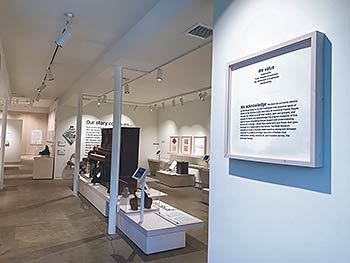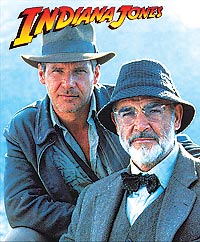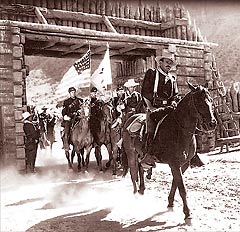by Moab Museum Staff
 |
| Indigenous Land Acknowledgement Statement on display at the Moab Museum. |
“It is important to understand the longstanding history that has brought you to reside on the land, and to seek to understand your place within that history. Land acknowledgements do not exist in a past tense, or historical context: colonialism is a current ongoing process, and we need to build our mindfulness of our present participation.” – Northwestern University
In 2020, the Moab Museum adopted its first Indigenous Land Acknowledgement Statement. It pays respects to the original settlers of the Moab Valley; the People who came before European settlers—the First Peoples. But it also pays respects to their descendants presently thriving in Moab and across the region.
The Moab Museum’s Land Acknowledgement reads as follows:
We acknowledge the land we currently identify as the Moab Valley to be the traditional and ancestral lands of bands of the Nuutsui (Ute) and clans of Ancestral Pueblo People. We pay our respects to all their elders, past and present, and choose to honor and acknowledge the original stewards of this land in hopes of building mutual respect and understanding across all cultures – those that reside here and those that pass through here today and in the future. The Moab Museum intends to foster a mutual understanding among and between cultures to produce stronger and more effective civic interactions among citizens of, and travelers across, the Colorado Plateau.
When we discuss the region more broadly, we acknowledge the Paiute, Hopi, Zuni, and Diné, who also share deep ties to this region.
During November’s National Native American Heritage Month, we reexamine our motives for having a Land Acknowledgement Statement and what it means to be authentic about it. Recent dialogues from local and national Native communities highlight the complications with this latest attempt by institutions to address historic wrongs. In a recent article published in Outside Magazine, Dr. Len Necefer, CEO Founder of Natives Outdoors, and member of the Navajo Nation, shares, “acknowledgements can have the unintended consequence of framing Indigenous people’s issues as antiquated and limited to land, glossing over the most brutal acts as a result.” The very language used in documents like a Land Acknowledgment, or even the Native American Graves Repatriation Act of 1990, ignores or unknowingly erases cultural views by contextualizing the matter from a western perspective. For example, “a focus solely on land oversimplifies many other varying beliefs. For some Indigenous people, while the land is important, bodies of water—rivers, lakes, and the ocean—hold significantly more cultural relevance. For other tribes, the dream world may be a much more central component of their lived experience,” per Dr. Necefer. To some Native cultures, it isn’t just about land, and the very phrase “Land Acknowledgement” misses the point.
Suggestions for authenticity include building real, authentic relationships with Indigenous people, compensating Indigenous people for their emotional labor (instead of casually requesting free counsel), and understanding displacement and how it plays into land acknowledgment. Are we simply checking a box, or are we demonstrating our commitment to change through our actions?
The Moab Museum has only begun building relationships with Native communities, listening to their concerns, and honoring their requests to change how we include First Peoples’ stories in our exhibits. The Museum currently displays five ancestral objects, each curated with care and cultural accuracy. Prior to the redesign, the Museum exhibited more than fifty objects, all beautiful to observe, but not always accurately depicted. Today we prioritize consultation and including text directly from those consultations. Our current special exhibit, Hopi Katsina: Evolving Styles, Enduring Meaning, features a contemporary representation (per the request of local tribes) of Native culture and lifeways.
Our exhibits and programs seek to present authentic, whole stories of Native communities both in the past and today. We recognize that the road ahead to accomplishing this is long, and we will make mistakes. But, we continue to commit to authenticity and cultivating a space that is both representative and welcoming to our diverse community. As we observe Native American Heritage Month, we invite our community of Museum visitors to join us in reexamining our cultural understanding of Native history, and expanding our knowledge of what it means to be Indigenous in America today.
Sources:
Native Governance Center – A Guide to Indigenous Land Acknowledgement
Outside Magazine: We Need to Reframe Why We Do Land Acknowledgements by Len Necefer
Northwestern University (Evanston, IL) - Native American and Indigenous Initiatives
118 East Center Street, Moab — 435-259-7985 — moabmuseum.org
 Red Cliffs Lodge, on the banks of the mighty Colorado River, is home to the Moab Museum of Film & Western Heritage. The lodge is built on the old George White Ranch, a key location for nine of the big westerns including Rio Grande, Cheyenne Autumn, Ten Who Dared, The Commancheros, and Rio Conchos.
Red Cliffs Lodge, on the banks of the mighty Colorado River, is home to the Moab Museum of Film & Western Heritage. The lodge is built on the old George White Ranch, a key location for nine of the big westerns including Rio Grande, Cheyenne Autumn, Ten Who Dared, The Commancheros, and Rio Conchos.
The late George White was founder of the Moab to Monument Valley Film Commission, the longest ongoing film commission in the world.
In the museum one can learn more about film locations, how the sets are built, and how the filming process is managed on nature’s own sound stage. On display in the museum are production photographs, movie posters, autographed scripts, props from the many pictures filmed in the area, and displays about the western ranching heritage. For information, call Red Cliffs Lodge at 435-259-2002.
 Through the magnificent landscapes of southeastern Utah, writers have been inspired and stories born here. Zane Grey, the famous western novelist, traveled through the area in 1912. His visit inspired him to write his book Riders of the Purple Sage. The book was made into a movie starring Ed Harris and Amy Madigan, and filmed on locations around Moab.
Through the magnificent landscapes of southeastern Utah, writers have been inspired and stories born here. Zane Grey, the famous western novelist, traveled through the area in 1912. His visit inspired him to write his book Riders of the Purple Sage. The book was made into a movie starring Ed Harris and Amy Madigan, and filmed on locations around Moab.
| A partial list of stars that have made movies in Moab John Wayne, Maureen O'Hara, Henry Fonda, Lee Marvin, Rock Hudson, Jimmy Stewart, Richard Boone, Anthony Quinn, Mickey Rooney, Shirley Temple, Kris Kristofferson, Billy Crystal, Robert Duvall, Gene Hackman, Bill Murray, Jack Palance, Susan Sarandon, Geena Davis, Ted Danson, Tom Cruise, and many more. |